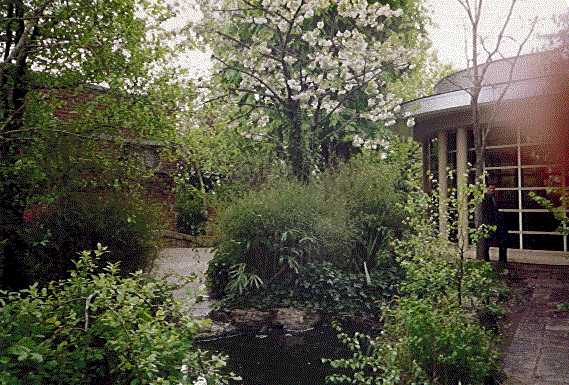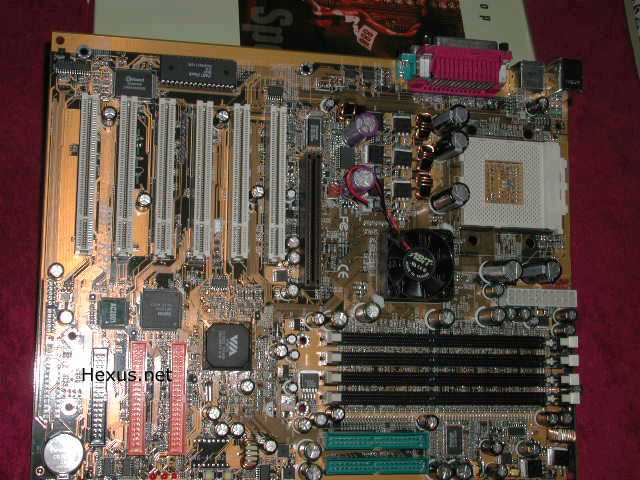ABit Roadshow 2001 Report
Article - the world's biggest motherboard manufacturer takes over the Kensington Roof Gardens and shows us what it's been up to
Yesterday lunchtime, selected press assembled at the Kensington Roof Gardens to hear from the world's biggest manufacturer of motherboards; ABit. Amidst flamingos and a spectacular barbeque we were told about ABit's latest products and the things that make their motherboards, graphics cards and sound equipment so successful.

When the chips are down
We were shown an incredible number of motherboards from all walks of life at the event - Pentium III motherboards printed on white PCB, Pentium 4 motherboards using RAMBUS and SDRAM, and Athlon motherboards using SDRAM and DDR RAM. We even saw how ABit aims to help overclockers and system tweakers using something they call "ABit Engineered" features. In terms of motherboards, the ones that really caught my eye were the KR7-RAID and KG7-RAID, the company's very latest Athlon boards featuring four unbuffered DDR RAM slots - the first ever to do it, one using VIA's KT266 chipset and one with AMD's 760 chipset. There was also a look at the TH7II-RAID, the follow up to the successful TH7-RAID featuring all the refined features of the first board, four RAMBUS RIMM slots, and support for the new Socket 478 Pentium 4 processors which we ran into at ECTS. Elsewhere we were interested to see the BL7-RAID and BW7-RAID, ABit's first Pentium 4 boards to use SDRAM technology, the former supporting the newer Socket 478 chips and the latter Socket 423 chips. Like so many others this year, the show was unfortunately somewhat noteworthy for its absentees more than anything. No nFORCE and no DDR-based Pentium 4 boards, which we had perhaps expected to see. In the question and answer phase of the presentations, ABit representative Scott Thirlwell was put on the spot with regard to the Pentium 4 DDR situation, and admitted that the 845-based boards were on the way, perhaps towards the end of October. He also had some tough questions to answer on the topic of VIA's Pentium 4 chipset, the subject of extraordinary legal tussles at the moment. ABit wants to avoid uncertainties, he said, one reason it waited so long before using the KT266 chipset, he added. nFORCE didn't even get a look in as far as the presentation was concerned, but we gleaned some information during our subsequent meal. Apparently it won't be long, with boards perhaps arriving "in Q4". As far as nFORCE is concerned, we have heard that MSI will be the first customer.

Speed freaks
Sharing the floor were Danish technoboffins Vapochill, who were demonstrating their product's abilities to overclock the Pentium 4. Although we initially heard that the starting chip was a Pentium 4 1.7GHz, it turned out that it was a 2GHz chip, making the 2.4GHz figure we were shown all the more believable. Vapochill were bombarded with incredulities shortly after their presentation though, during which they claimed that within five years heatsinks will no longer be an effective source of cooling. Falling back on the result of apparent meetings with Intel, representative Martin Schousboe said that it wasn't just Vapochill, but chip companies themselves which were starting to accept this reality. Afterward, we were quickly shown the new ABit sound enclosures, with thumping subwoofer and surround sound speaker setup. The SP-60 was certainly very imposing as we experienced the ferocity of the incredible lobby scene from The Matrix for the millionth time, but we were more interested in the graphics cards. For us the big announcement wasn't the collection of GeForce 2 MX-derived Siluro cards but the big one, the GeForce 3 Siluro. The card, which Scott Thirlwell was forced to admit would probably retail for more than $300 when it hit, is a 64Mb beast designed from the ground up to allow for extreme overclocking. ELSA's Gladiac 920 is now geared towards overclockers, but it's thought that their mileage will be much less impressive than ABit's. We'll have to wait and see, of course. As for the rest of the show, one of the things we were most interested to hear about was the ABit Engineered features of some of the company's latest motherboards. ABit, we were told, is a company obsessed with self-improvement, and it breeds an air of innovation. Many of the research and development staff responsible for the original breakthroughs - SoftMenu, jumperless board adjustment etc - are still with the company, something very unusual in this industry. ABit Engineered is another example of this. It literally came about when the bigwigs upstairs wandered down to the R&D department and had a look inside the PCs of their staff. The modifications performed by research staff on their own machines to improve their stability and abilities have now been, wherever possible, adapted into an "ABit Engineered" feature for use on new boards as standard. The examples given were : voltage mods, all Athlon boards now go up to 2.2v; overclocking strips, literally little white strips on the back of the PCB to help cut out electromagnetic interference buildup; LEDs for monitoring system conditions - similar to those found on ASUS boards - so that if something goes wrong during boot-up you get a code, and the manual tells you what's wrong depending on the number displayed; and motherboard-mounted power and reset switches, perfect if you spend a lot of time under the bonnet testing boot-up conditions.
Conclusion
When we left Kensington we were quietly impressed by ABit's demonstrations, but also a little perturbed by them. The lack of nFORCE and DDR-based Pentium 4 boards was peculiar, as was the absence of these exotic ABit Engineered features on one of their as-yet unreleased Athlon boards, the KR7-RAID. Nevertheless, we couldn't possibly complain about the food.
-

